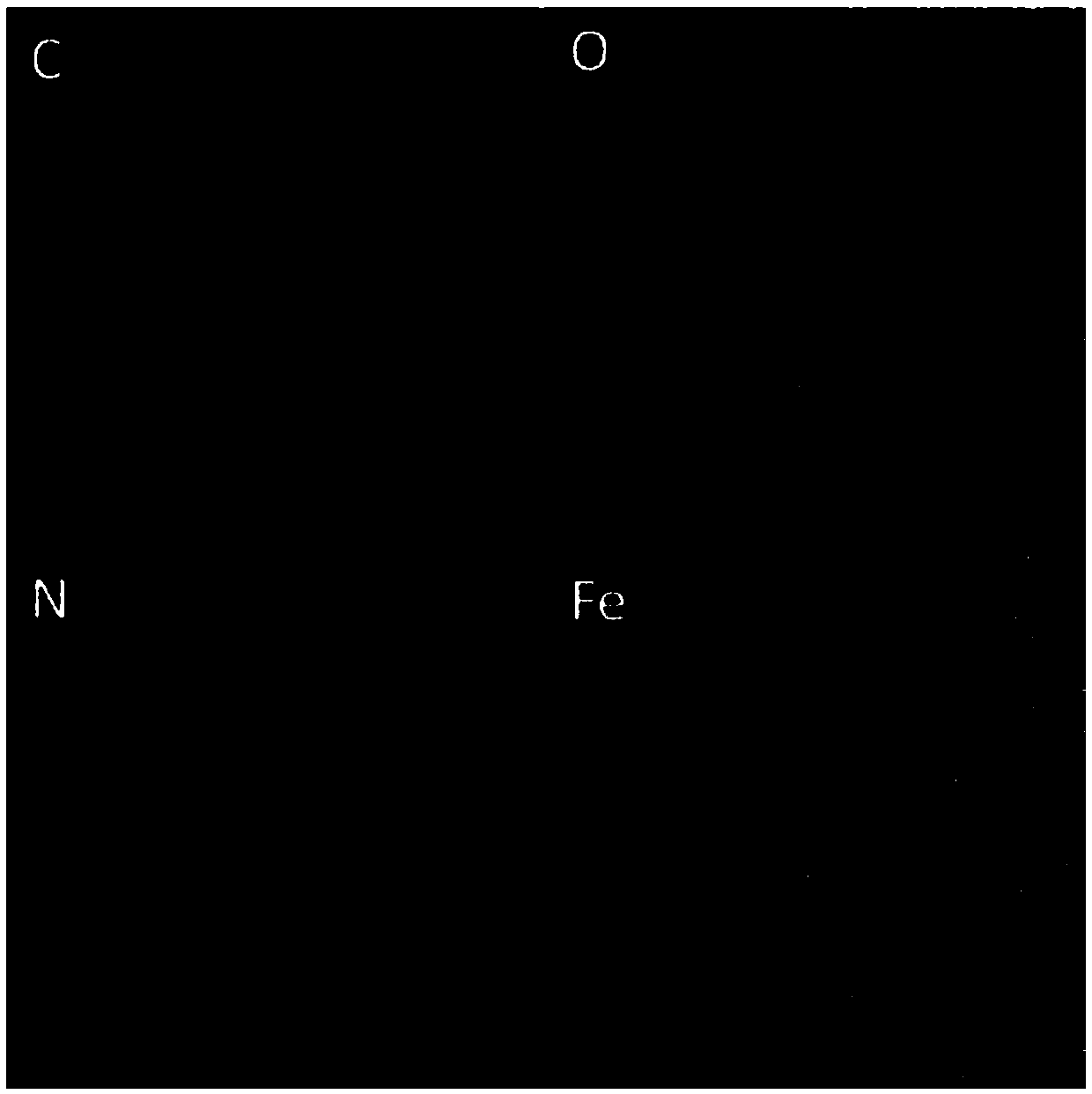Recyclable preparation method of microporous iron-nitrogen-doped carbon catalyst material
A nitrogen-doped carbon and cyclic preparation technology, which is applied to electrical components, battery electrodes, circuits, etc., can solve the problems of increased production and processing complexity, large size, and rare micro-mesopores, so as to improve catalytic performance and current density , mild experimental conditions and simple synthetic methods
- Summary
- Abstract
- Description
- Claims
- Application Information
AI Technical Summary
Problems solved by technology
Method used
Image
Examples
Embodiment 1
[0034] Weigh 4.97g of ferric chloride hexahydrate, add 38ml of water and stir to dissolve to form 40ml of ferric chloride solution. After stirring at room temperature for 0.5 hours, quickly add 0.55ml of pyrrole liquid, the concentration of pyrrole monomer is 0.2mol / L; continue stirring at room temperature for 5 Hours later, the polypyrrole precursor (Fe ions / PPy ① ) and iron ion filtrate ① ; the Fe ions / PPy ① After stirring and mixing with 5g of zinc chloride and 15ml of water, put it into a blast drying oven at 60°C to dry to obtain Fe coated with zinc chloride. ions / PPy ① Precursor (ZnCl 2 / Fe ions PPy ① );
[0035] The dried ZnCl 2 / Fe ions / PPy ① Put it into a tube furnace, ventilate with a nitrogen flow rate of 50ml / min for 0.5 hours, then raise the temperature to 900°C at a heating rate of 5°C / min, keep it for 2 hours, and cool to obtain a carbonized product;
[0036] Grind the carbonized product into a powder, add 20ml, 1mol / L hydrochloric acid and soni...
Embodiment 2
[0045] To the about 38ml iron ion filtrate collected in example 1 ① Add 1ml of 30wt% hydrogen peroxide to the mixture, stir for 0.5 hours, then quickly add 0.55ml of pyrrole liquid, continue to stir for 5 hours at room temperature, and obtain the polypyrrole precursor (Fe ions / PPy ② ) and iron ion filtrate ② ;
[0046] Will Fe ions / PPy ② After stirring and mixing with 5g of zinc chloride and 15ml of water, put it into a blast drying oven at 60°C to dry to obtain Fe coated with zinc chloride. ions / PPy ② Precursor (ZnCl 2 / Fe ions / PPy ② );
[0047] The dried ZnCl 2 / Fe ions / PPy ② Put it into a tube furnace, ventilate with a nitrogen flow rate of 50ml / min for 0.5 hours, then raise the temperature to 900°C at a heating rate of 5°C / min, keep it for 2 hours, and cool to obtain a carbonized product;
[0048] Grind the carbonized product into powder, add hydrochloric acid filtrate ① Ultrasonic for 1 hour, microporous iron-nitrogen doped carbon was obtained by suctio...
Embodiment 3
[0050] To the about 36ml iron ion filtrate collected in example 2 ② Add 1ml of 30wt% hydrogen peroxide to the mixture, stir for 0.5 hours, then quickly add 0.55ml of pyrrole liquid, continue to stir for 5 hours at room temperature, and obtain the polypyrrole precursor (Fe ions / PPy ③ ) and iron ion filtrate ③ ;
[0051] Will Fe ions / PPy ③ After stirring and mixing with 5g of zinc chloride and 15ml of water, put it into a blast drying oven at 60°C to dry to obtain Fe coated with zinc chloride. ions / PPy ③ Precursor (ZnCl 2 / Fe ions / PPy ③ );
[0052] The dried ZnCl 2 / Fe ions / PPy ③ Put it into a tube furnace, ventilate it with a nitrogen flow rate of 50ml / min for 0.5 hours, then raise the temperature to 900°C at a heating rate of 5°C / min, keep it for 2 hours, and cool to obtain a carbonized product;
[0053] Grind the carbonized product into powder, add hydrochloric acid filtrate ② Ultrasonic for 1 hour, microporous iron-nitrogen doped carbon was obtained by suc...
PUM
| Property | Measurement | Unit |
|---|---|---|
| Diameter | aaaaa | aaaaa |
Abstract
Description
Claims
Application Information
 Login to View More
Login to View More - R&D
- Intellectual Property
- Life Sciences
- Materials
- Tech Scout
- Unparalleled Data Quality
- Higher Quality Content
- 60% Fewer Hallucinations
Browse by: Latest US Patents, China's latest patents, Technical Efficacy Thesaurus, Application Domain, Technology Topic, Popular Technical Reports.
© 2025 PatSnap. All rights reserved.Legal|Privacy policy|Modern Slavery Act Transparency Statement|Sitemap|About US| Contact US: help@patsnap.com



